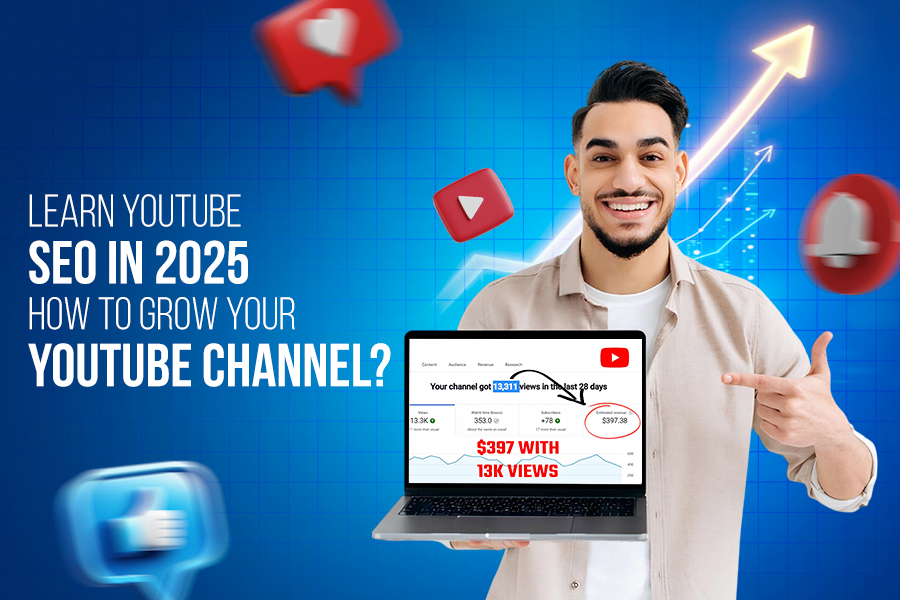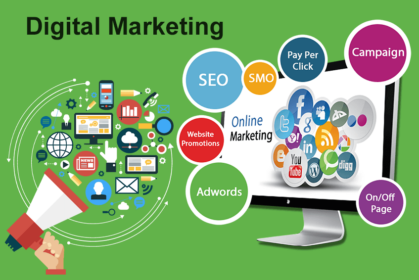
Are you a YouTube creator struggling to rank content on the platform? Well, today, developing great content is not enough! If you think, you can provide value to the audience through your content without a strategy, you’re wrong. Although creating valuable content is a prerequisite on YouTube, YouTube content strategy is equally paramount. This is where YouTube SEO comes into play.
People usually ask the wrong question. Instead of asking whether the YouTube algorithm is important or not, they should ask about the cost of ignoring it. The YouTube Algorithm is everything and you must develop YouTube SEO strategies that align well with these algorithms.
It doesn’t matter if you’re a seasoned professional or a novice, who’s just starting with YouTube content creation, considering YouTube SEO best practices and algorithms, is essential for ranking and optimising your content.
Moreover, learning YouTube SEO isn’t just about growing your channel—it’s also a gateway to building a successful career in digital marketing. With businesses and brands increasingly turning to video content, SEO-savvy creators are in high demand.
If you’re confused about how to leverage YouTube SEO to align with the algorithm and make your content rank in this highly competitive platform, worry no more! We are here for you.
In this blog, we will explore how the YouTube algorithm works. We will also discuss the various aspects of YouTube SEO and the steps to grow your YouTube channel. Furthermore, we will also provide insights on how YouTube can be leveraged as a marketing tool. We will also talk about monetising your YouTube content and optimisation practices. There are so many things to cover. So, without further ado, let’s dive right in.
How does the YouTube Algorithm Work?
Before understanding the ways to grow your YouTube channel by leveraging YouTube SEO and considering YouTube ranking factors, you should have a clear idea about the algorithm and how it works. This way, you can align your YouTube SEO strategies with algorithms to rank your content. So, in this section, we will explore that.
What is YouTube Algorithm?
Have you ever noticed that the YouTube recommendations are aligned with your preferences? Based on the previous searches and views, it recommends content that is highly relevant and engaging to you. Isn’t it?
This is exactly how YouTube algorithm works. Hence, it is a recommendation system that decides which videos are recommended to whom. Its job is ranking content based on user preference, using signals like quality, user behaviour, and relevance.
According to a recent study by MIT Technology Review, the algorithm drives around 70% of the views on YouTube. In reality, there are instances where the code overrides user controls. This means, that even if you dislike a particular piece of content, the YouTube algorithm still continues recommending similar ones. But that’s rare.
Now that we know all about the algorithm, let’s see how it works in 2025!
How Does It Work?
“Our algorithm doesn’t pay attention to videos, it pays attention to viewers. So, rather than trying to make videos that’ll make an algorithm happy, focus on making videos that make your viewers happy.”— YouTube’s own view on reaching the audience.
This is quite an interesting point. The algorithm does not recommend content based on popularity but focuses on the likelihood of an individual user watching a video and the next. So, it emphasises personalisation and relevance more than popularity and quantity.
This is why two viewers can get completely different results for a similar search. There are two factors to consider here:
- Content characteristics
- Recommendation location
Let’s explore these in detail which can make you a YouTube creator who knows how to leverage algorithms to boost YouTube search optimisation.
1. Content Characteristics
Forget the idea that YouTube watches the videos while picking its favourites. YouTube algorithm cannot do that. Instead, it seeks signals or characteristics of content that align well with user preferences.
Firstly, it looks for signals of relevance. For instance, you search for how to make a cake. YouTube finds all the content that matches the query. If the YouTube algorithm isn’t watching each and every video, then how is it showing the relevant content to you? The answer is metadata in tags, descriptions, and titles.
Then comes performance signals. The algorithm isn’t quite an actual critic. However, it seeks clues that show the content to be good through certain metrics. It asks the following questions:
- How long have people watched the video?
- How often is the video being watched?
- How many people liked the video?
Signals of personal preference are another thing the algorithm considers. Since the algorithms aim to provide viewers with an ideal mix of content, they rely partially on user preferences.
To create your mix, the platform considers the videos that you’ve liked or watched and what topics intrigue you, encouraging you to keep coming back.
Finally, the algorithm looks for creator signals. Today, social media platforms are highly regulated. They make sure not to promote harmful, dangerous, or untrustworthy content. So, YouTube regulates this by reviewing the channel based on topical authority, trustworthiness, and relevance. Then they push content to the user’s personalised recommendations.
2. Recommendation Location
Do you think YouTube algorithm is a singular concept? You are wrong! In fact, there are three spaces where recommendation happens. Each of these has different criteria for content suggestion.
The first one is the homepage. It’s the one that you see when you first get on YouTube. In this section, the algorithm has no idea about the mood of the user. The recommendations in this section are simply based on performance factors and your search history.
Then, there are suggested videos. They pop up next to the video you are watching. In this section, the algorithm has a better comprehension of your current mood and suggests content according to your mood and search history. The algorithm also recommends the frequently watched video after the video you’re currently watching.
Finally, the search result is the section that the algorithm considers. This is a straightforward section. You’re basically telling YouTube what you want to watch. Seems simple, right? What if we tell you that everyone’s search results are different? Search for “cricket” and see what happens!
You can get cricket game videos. Not interested in sports? You can surely expect some flying insect videos. In this instance, the algorithm will try to balance relevancy signals with your behaviour by looking at the description and title of the videos.
What is YouTube SEO?
Now that you know all about the algorithm and how it works, let’s understand what YouTube SEO is.
YouTube has a search engine of its own. Do the videos you create rank at the top of the search results based on keyword relevancy? If not, then YouTube SEO is the solution to it! This can boost the channel visibility significantly.
YouTube SEO is all about assisting the YouTube algorithms comprehend your content and suggest it to the relevant users, resulting in driving a higher degree of audience engagement.
YouTube SEO or YouTube search engine optimisations is simply the process of video optimisation, increasing their chances of ranking in YouTube search results. Not only that, but popular search engines have a section dedicated to videos on every topic.
In this section, your video can rank, which can drive another set of audiences for the valuable content you’re uploading on YouTube.
A highly optimised video on YouTube with the appropriate SEO elements not only boosts engagement but also attracts many users through enhanced visibility.
There are a wide variety of YouTube SEO strategies that can help you achieve all of these.
- Performing keyword research
- Adding hashtags to your videos
- Creating a playlist
- Optimising your video descriptions and titles
- Making the best use of YouTube tags
- Creating compelling thumbnails
- Promoting your content across other social media networks
- Regular assessments using analytic tools
We will delve deep into these in the sections later. For now, let’s understand what the need for YouTube SEO is.
Why do you Need YouTube SEO?
How many videos are there on YouTube? Nine hundred million? 1 billion? Well, it turns out that there are approximately 14 billion videos on YouTube! That’s more than one and a half videos for everyone on the planet. However, that’s the figure if we count the publicly available ones.
Can you gauge the extent of competition that exists, even in your niche from that figure? You simply can’t ignore YouTube SEO to stand out.YouTube SEO, a part of digital marketing, can be considered one of the most in-demand skills of 2025.
If you upload content on YouTube without a clearly charted YouTube SEO strategy, possibilities are they will end up lost in a pile of other relevant videos on that niche.
Here are some reasons why you need YouTube SEO, even in 2025.
1. Increases Visibility
If you optimise your videos to rank on YouTube (and in Google), you increase your chances of being found in this vast sea of the internet. When someone enters a search query, the algorithm will assess their video’s metadata, determining content relevancy and suitability based on the query.
2. Engagement Enhancements
As mentioned above, the algorithm also considers engagement metrics like likes, watch time, comments, and shares when ranking content on YouTube. YouTube prefers videos that keep the user engaged for hours. By optimising the metadata, you can increase your chances of being found by relevant users who will engage with your content.
3. Driving Traffic
This is true especially if you have a product and service that you promote through your videos. YouTube SEO can increase the click-through rate which might land them on your website or other social media handles. This, in turn, drives considerable traffic to your website.
4. Brand Awareness
There is no denying the fact that YouTube is an exceptional platform for building a solid brand awareness. The creation of high-quality content optimised according to YouTube SEO can highlight your brand’s USP (Unique Selling Proposition) while resonating well with the target audience.
Steps to Grow Your YouTube Channel
Now that we understand the YouTube algorithms, its working, YouTube SEO, and its needs, let’s explore how to practically grow your YouTube channel. By following these steps you will not only rank your content but will drive considerable engagement achieving your personal or business objectives.
Step 1: Finding Untapped Keywords in YouTube SEO
When talking about ranking your content on YouTube, keyword research is the most important thing. In reality, selecting the correct keyword can impact your video performance. For this, you have to follow these steps:
Listing Seed Keywords
Seed keywords are the words or phrases that describe broad topics. For instance, if you create content in a digital marketing niche, seed keywords will normally include:
- Social media
- Content marketing
- LinkedIn marketing
Do you know how that works? These are the niche-specific topics your video can revolve around. However, seed keywords are super competitive. So, how does it help? The next step will answer that.
Typing Seed Keywords in YouTube Search
It is the time to convert a seed keyword to different relevant long-tail keywords. How? From YouTube Suggest! This is similar to Google. Type in the seed keyword and see what YouTube suggests. So, at this stage, you will have a range of long-tail keywords at your disposal.
Seek Low-Competition Keywords
So, you will want to optimise your content around the keywords that not only get a lot of searches but are not highly competitive. There are various tools online that can help you shortlist these keywords like TubeBuddy.
Now that you know how to do the keyword research, let’s move on to the next step.
Step 2: Watch Time Optimization for YouTube SEO
Let’s face the fact: YouTube’s top priority is to retain people on the platform. The more people spend time on YouTube, the more money the platform makes through running ads.
That’s the reason why the algorithm focuses so much on watch time. Unaware of the term watch time? Let’s break it down to a simpler version. It is the time people watch a video. The more people spend time watching the video, the more views you can gather.
But how to create videos that keep people engaged and hooked? Let’s find out.
Long Videos
If all the other aspects are similar, long videos perform much better than short videos. Don’t believe us? According to a study, longer videos perform much better than shorter videos.
This is because YouTube encourages content that keeps people on the platform for a longer period. Plus, longer videos enable more overall value from a single piece of content.
Cut Out Fluff from Video Introductions
The first 15 seconds is what can make or break your video performance. You have to cut out the background information.
Who wants a video starting with sentences that beat around the bush instead of coming straight to the point? By cutting or eliminating the fluff from the video introductions, you can hook the user right away. However, the content should be highly engaging and intriguing.
Incorporation of Pattern Interrupts
Static and plain videos aren’t relevant anymore. They bore the users which can leave your videos unwatched. So, what to do? Pattern interrupts!
Pattern interrupts are simple video elements that are different from the rest of the video. It includes things like:
- Animations
- Different camera perspectives
- Graphics
- Changing background
- This makes the video more engaging and intuitive, which keeps the user’s interest alive.
Proper Planning
This is the most important thing to consider in this step. Are you camera shy? Don’t worry, most of us are. So, write a script beforehand and practice it before actually shooting the video.
Better structuring can help people understand your perspective and engage more with your videos. This ensures super crisp video delivery.
Step 3: YouTube SEO for your Videos
By now, you know the importance of YouTube SEO. But, how to attain the perfect optimisation? Let’s see!
Keyword-Optimising the Video Title
Keyword-optimising is crucial as it allows the video to reach the target audience. This increases your video’s visibility, which can lead to more views.
Be sure to incorporate the exact term that explains the video intent effectively.
Titles that Maximise CTR
As a ranking signal, YouTube also uses CTR just as Google. This means the greater the number of clicks on your video, the more YouTube promotes it.
For that, you must clearly state the video’s benefits in the title. Remember, don’t resort to clickbait.
YouTube SEO for YouTube Video Descriptions
YouTube states that short descriptions can hurt your video rankings. That’s why writing comprehensive and long descriptions is pivotal for YouTube SEO.
Tag Optimisation
You have to optimise the YouTube tags. How to do this? Let’s find out.
- You can use 2-3 tags including the keyword along with close variations.
- Add two tags describing the topic of your video including words that are absent in the main keyword.
- Add 2 tags that display the industry or niche.
Step 4: Unique and Appealing YouTube Thumbnails
How to create an aesthetically appealing and engaging YouTube thumbnail? Here’s how!
Firstly, use a lot of contrast. You will want to clash the thumbnail colours as much as possible. Secondly, use colours that make your brand stand out from the rest of the videos in your niche.
Step 5: Promotion of Optimised Playlists for YouTube SEO
It is one of the most underrated strategies to gain more views and boost subscriber count. Do you know why?
It’s because playlists can boost your session time significantly. But, what is the session time? It is the time people spend on YouTube after watching the content you offer.
Session time is a crucial ranking factor for YouTube and the platform really cares about that.
Step 6: YouTube Cross-Promotion
Finally, promotion of your videos to the right audience is one of the most crucial steps. You can’t expect your videos to always pop up in the target audience’s feed. Just like blogs, you need to push your videos through other social media platforms.
This push includes sharing short and engaging clips of your video on different platforms. You can even push your videos through a coordinated email outreach strategy.
How to Choose the Perfect Niche for your YouTube Channel?
Selecting a niche is one of the necessary decisions that a creator has to take apart from YouTube SEO. If you are unaware of your niche, neither your audience nor the YouTube algorithm will know what to do with the content.
Here are certain YouTube creator tips you can follow when deciding your YouTube niche.
1. Your Passion Should Be Your YouTube Niche
You have to ask yourself about the things you’re passionate about. This can be anything. Your passion can be your source of motivation, even in the initial days with minimal views. This will encourage you to go on, maintaining consistency.
2. Check the Trends
While passion is important, doing some research to identify gaps in content is also necessary. These gaps can be utilised by you to create content that’s not available in the market. Even, YouTube’s search bar can act as an important tool for understanding the demands of the users.
3. Don’t Create Repetitive Content
While taking inspiration and learning from other YouTubers is great, you need to produce unique videos. This will enable you to build a loyal set of followers and subscribers with your unique voice.
You don’t want to become a creator who copies. For that, finding and understanding your niche is a key.
How to Get Organic Views for Your YouTube Videos?
Who doesn’t want to gather views for their YouTube videos organically! It doesn’t only portray the fact that your videos are optimised as per YouTube SEO best practices, but also displays that it brings value to the users. These steps can be followed for that purpose:
- You have to be consistent. Just like all other social media, consistency matters on YouTube as well.
- You should practice robust tagging. The limit for tagging is 500 characters. So, make sure to use all those characters, crafting relevant tags.
- Usage of multi-lingual captions can help significantly. This is because YouTube is the second-largest search engine, accessible in 80 languages and more than 100 countries.
- Optimising the videos for mobile can help users access your video when they are not on a desktop or laptop.
- You can create end-screens for all your videos. This entails links to your other videos and profile, ensuring a continuous user engagement with your YouTube page.
- Try to be the face of the business you’re promoting through your videos. This personifies the brand, forging stronger connections with your target audience.
How to Monetise Your YouTube Channel?
Let’s face the fact: Money is one of the biggest motivators. So, the end goal of optimising your videos through YouTube SEO is either getting conversions for your business or monetising the content for a stable career. Here, we present you 5 ways to monetise your YouTube channel.
1. YouTube Ads
This is the most basic, accepted, and simplest way to monetise your content. These advertisements appear during the course of videos that can be controlled through different YouTube ad Formats.
2. Affiliates
So, you are watching a video on YouTube. Have you noticed CTAs in the form of links that the creator puts or asks you to visit a company website or purchase their services and products? Well, that’s affiliate marketing. You can earn a percentage as a commission each time a user purchases through your link.
3. Channel Membership
Channel memberships entail a monthly membership for various benefits like one-on-one chats, product discounts, and exclusive content.
4. Paid Sponsorships
This monetisation strategy includes getting a brand sponsor your content in exchange for product demonstrations, discussion, and usage of their products or services in your content.
5. Super Features
This feature comes in three different forms and is associated with YouTube live streams.
- Super chat highlights the paid user’s messages over everyone else.
- Super Stickers is where these users buy and share appealing and eye-catching stickers to be displayed at the top of the chat.
- The Super Thanks feature enables users to share love with their most-favored creators.
All the revenue coming from your live stream through the smart features goes to your pocket.
Webskitters Academy: Your Go-To Institute for Digital Marketing
So, while considering doing your YouTube SEO to optimise your YouTube videos, you have to understand how the YouTube algorithm works. And then, you have to craft a strategy that works well for you.
Choosing the right YouTube keyword and enhancing your metadata isn’t enough. Providing value and context is as important as other SEO strategies. However, don’t stop once you achieve the desired results. You have to constantly monitor the video activity and consistently provide content.
Convinced enough but don’t know where to start? Hear us out! Webskitters Academy is here for you.
Webskitters Academy offers exceptional digital marketing courses with AI. The course is specially designed to equip students with comprehensive digital marketing skills. Our extensive curriculum guarantees every topic relevant to the modern digital marketing field including AI.
So, are you ready to conquer the digital marketing space? Book a call with us and boost your career!
Search
I Want to Learn...
Category
Explore OurAll CoursesTransform Your Dreams
into Reality
Subscribe to Our Newsletter
"*" indicates required fields
 Independence Day Offer | Upto 20% Discount on all course fees
Independence Day Offer | Upto 20% Discount on all course fees 





